University of Adelaide
The University of Adelaide (informally Adelaide University) is a public university located in Adelaide, South Australia. Established in 1874, it is the third-oldest university in Australia. The university's main campus is located on North Terrace in the Adelaide city centre, adjacent to the Art Gallery of South Australia, the South Australian Museum and the State Library of South Australia.
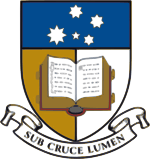 Coat of Arms of the University of Adelaide | |
| Latin: Universitas Adelaidensis | |
| Motto | Sub Cruce Lumen |
|---|---|
Motto in English | "The light (of learning) under the (Southern) Cross" |
| Type | Public |
| Established | 1874 |
| Endowment | $265.7 million[1] |
| Budget | $929 million[2] |
| Chancellor | Catherine Branson[3] |
| Vice-Chancellor | Mike Brooks |
Academic staff | 1,481[4] |
Administrative staff | 1,920[4] |
| Students | 27,357 (2018)[4] |
| Undergraduates | 20,005 (2018)[4] |
| Postgraduates | 7,352 (2018)[4] |
| Location | , , Australia 34°55'14.4"S 138°36'19.3"E |
| Campus | Urban: North Terrace Suburban: Waite, Thebarton, and the National Wine Centre Rural: Roseworthy Overseas Education Centre: Singapore |
| Colours | Black, white, red, gold, and blue |
| Affiliations | Member of the Group of Eight, ASAIHL, ACU |
| Website | www.adelaide.edu.au |
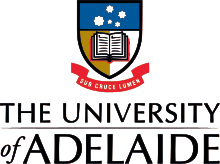 | |
The university has four campuses, three in South Australia: North Terrace campus in the city, Roseworthy campus at Roseworthy and Waite campus at Urrbrae, and one in Melbourne, Victoria. The university also operates out of other areas such as Thebarton, the National Wine Centre in the Adelaide Park Lands, and in Singapore through the Ngee Ann-Adelaide Education Centre.
The University of Adelaide is composed of five faculties, with each containing constituent schools. These include the Faculty of Engineering, Computer, and Mathematical Sciences (ECMS), the Faculty of Health and Medical Sciences, the Faculty of Arts, the Faculty of the Professions, and the Faculty of Sciences. It is a member of the Group of Eight and the Association of Commonwealth Universities. The university is also a member of the Sandstone universities, which mostly consist of colonial-era universities within Australia.
The university is associated with five Nobel laureates, constituting one-third of Australia's total Nobel Laureates, and 110 Rhodes scholars. The university has had a considerable impact on the public life of South Australia, having educated many of the state's leading businesspeople, lawyers, medical professionals and politicians. The university has been associated with many notable achievements and discoveries, such as the discovery and development of penicillin, the development of space exploration, sunscreen, the military tank, Wi-Fi, polymer banknotes and X-ray crystallography, and the study of viticulture and oenology.
History
.jpg)
(1875 engraving, Illustrated Australian News for Home Readers)
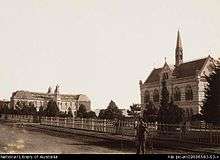
The University of Adelaide was established on 6 November 1874 after a £20,000 donation by grazier and copper miner Walter Watson Hughes, along with support and donations from Thomas Elder.[5]
The first Chancellor was Sir Richard Hanson and the first vice-chancellor was Augustus Short. The first degree offered was the Bachelor of Arts and the university started teaching in March 1876. John Davidson was the first Hughes professor of English literature and mental and moral philosophy.[6]
The university has a long history of championing the rights of women in higher education. It was the second university in the English-speaking world (after the University of London, 1878) to admit women on equal terms with men (1881), though women studied alongside men from the commencement of classes in 1876, and were equally eligible for all academic prizes and honours. Its first female graduate was Edith Emily Dornwell, who was also the first person in Australia to receive the degree of Bachelor of Science (BSc., 1885). The university also graduated Australia's first female surgeon Laura Fowler (MB, 1891). Ruby Davy (B. Mus., 1907; D. Mus., 1918) was the first Australian woman to receive a doctorate in music.[7] The university was also the first to elect a woman to a university council in Australia, Helen Mayo (MBBS, 1902), in 1914.[8]
The great hall of the university, Bonython Hall, was built in 1936 following a donation from the owner of The Advertiser newspaper, Sir John Langdon Bonython, who left £40,000 for a Great Hall for the University.[9]
Modern era
On 2 July 2010, the university officially implemented its "Smoke-Free Policy".[10] This move was the culmination of an anti-smoking agenda headed by Professor Konrad Jamrozik[11] and subsequently, following Jamrozik's death, the Executive Dean of the Faculty of Health Sciences, Professor Justin Beilby.[10] Security have the right to eject people smoking within the university buildings and also fine people smoking in the gardens or walkways. It is the first higher education institution in South Australia to institute a smoke-free policy.[10] The North Terrace campus has been smoke-free since July 2010, it was planned that the Waite and Roseworthy campuses would be smoke-free by 2011, and the university's residential facilities have also been made smoke-free.[10]
In June 2018, University of Adelaide and University of South Australia began discussions regarding the possibility of a merger. The proposition was described as the formation of a "super uni" by Steven Marshall and Simon Birmingham,[12][13] but the merger was called off in October 2018.[14]
Campuses
North Terrace
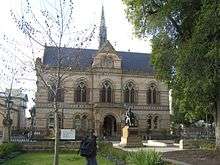
The main campus of the university is on North Terrace. It is bordered by the Art Gallery of South Australia, the State Library of South Australia, the South Australian Museum and the "City East" campus of the University of South Australia. The Adelaide University Medical and Dental Schools were located across Frome Road, behind the old Royal Adelaide Hospital (now Lot Fourteen). The hospital moved to the western end of North Terrace and so have the schools; the Medical School North and South buildings were renamed Helen Mayo North and South from 1 January 2018, in honour of Helen Mayo, a doctor at the Royal Adelaide Hospital and a graduate of the University of Adelaide.[15]
The vast majority of students and staff of the university are based at the North Terrace campus, where the majority of courses are taught and schools are based. The central administration of the university and the main library, the Barr Smith Library, are both located on this campus. While many other universities have law and business schools or satellite campuses within the central business district, the University of Adelaide is unique among Australian sandstone universities for having its main presence adjacent to the main business and shopping precinct.
Bonython Hall, (the great hall of the university), the Mitchell Building, the Elder Hall, the Napier building and the Ligertwood building, form the North Terrace street frontage of the campus. Bonython Hall is one of the many historic and heritage listed buildings located at the North Terrace campus. Others include the Mitchell Building, Elder Hall, and the Reading Room of the Barr Smith Library.
In 2016, the university commenced work on a $1 billion, 20-year "Masterplan" for its three campuses. The masterplan envisages new facilities for all schools, and greatly enhanced campus amenities for students, with a focus on pedestrians and cyclists, providing better, safer pathways through the campus, and eliminating vehicle traffic where possible. At North Terrace, the Schulz building will be repurposed as an on-campus residential college, with accommodation, and recreational facilities including a gym.[16] This major transformation of the university's physical presence across all campuses[17] comes in conjunction with the multimillion-dollar renewal and redevelopment of the old Royal Adelaide Hospital (RAH) site on North Terrace. In September 2017, the RAH moved to the western end of North Terrace, in the $4 billion South Australian Health and Biomedical Precinct (SAHBP), at which the University of Adelaide also has a physical presence in the form of the Adelaide Health and Medical Sciences Building.
In 2019 demolition work had begun on parts of the northern wall of the campus.
Waite
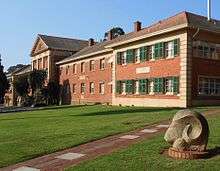
The Waite campus has a strong focus on agricultural science, plant breeding and biotechnology. The School of Agriculture, Food and Wine is based on the Waite campus and the campus contains components of the School of Earth and Environmental Sciences. It is adjacent to the Urrbrae Agricultural High School.
A number of other organisations are co-located in the Waite Research Precinct, including the South Australian Research and Development Institute (SARDI) (which is part of Primary Industries and Regions SA (PIRSA), whose headquarters are also at the campus); Australian Grain Technologies; the Australian Wine Research Institute.[18] the Commonwealth Scientific and Industrial Research Organisation (CSIRO); and the Australian Centre for Plant Functional Genomics (ACPFG).
It is situated in Adelaide's south-eastern foothills, in the suburb of Urrbrae on 174 hectares (430 acres). A large amount of the land was donated in 1924 by the pastoralist Peter Waite. A large amount of money was donated by Rosina and John, the widow and son of William Tennant Mortlock. These donations were initially used to establish the Peter Waite Institute of Agricultural Research (first Director A. E. V. Richardson),[19] which later became the Waite campus.
A Soil Research Centre was founded in 1929 with a donation of £10,000 from Harold Darling of J. Darling and Son, grain merchants.[20]
In 2004, Premier Mike Rann opened the multimillion-dollar Plant Genomics Centre at the Waite Campus.[21] Then in 2010 Premier Rann opened The Plant Accelerator, a $30 million research facility – the largest and most advanced of its kind in the world.[22]
Malcolm Oades was the director from November 1996 to 2001.
Roseworthy
Located north of the city, the Roseworthy campus comprises 16 km2 of farmland and is a large centre for agricultural research. It was the first agricultural college in Australia, established in 1883 and the first veterinary school in SA in 2008. Other organisations linked to the campus include SARDI and the Murray TAFE.
In 1991, the College merged with the University of Adelaide and became the university's Roseworthy Campus, part of the Faculty of Agricultural and Natural Resource Sciences. The merger would see teaching and research in oenology and viticulture transferred to the university's Waite Campus, along with the bulk of its work in plant breeding.[23] Before the degree in oenology was transferred to Waite Campus, Roseworthy produced a number of highly regarded and awarded winemakers and wine critics.[24]
From the mid-1990s, the major focus of the campus turned to dryland agriculture, natural resource management and animal production. The campus is also now home to South Australia's first veterinary science training program, which commenced in 2008. The new Veterinary Science Centre houses not only teaching facilities, including a surgical skills suite, but also a public veterinary clinic offering general practice as well as emergency and specialist veterinary services for pet animals. There are also specialised pathology laboratories in this centre for teaching, research and diagnostic work. In 2013, the veterinary science facilities were expanded with the opening of the Equine Health and Performance Centre, a state-of-the-art facility for equine surgery, sports medicine, internal medicine and reproduction.[25]
Other locations
National Wine Centre
Located in the Adelaide Park Lands at the eastern end of North Terrace, the Wine Centre offers some of the university's oenology courses. Opened in 2001, the facility also hosts public exhibitions about winemaking and its industry in South Australia.[26] It contains an interactive permanent exhibition of winemaking, introducing visitors to the technology, varieties and styles of wine. It also has a wine tasting area, giving visitors the opportunity to taste and compare wines from different areas of Australia.
The Wine Centre is situated at the eastern end of North Terrace, Adelaide in the eastern parklands and adjacent to the Adelaide Botanic Gardens. The building, designed by Cox Grieve Gillett, uses building materials to reflect items used in making wine.[27]
Thebarton
Thebarton is the base of the university's Office of Industry Liaison. The precinct works in conjunction with the University's commercial partners. Commercial enterprises at Thebarton include businesses involved in materials engineering, biotechnology, environmental services, information technology, industrial design, laser/optics technology, health products, engineering services, radar systems, telecommunications and petroleum services. The flames for the Sydney and Athens Olympic Games were developed at the Thebarton campus by the TEC group.[28]
Ngee Ann (Singapore)
The Ngee Ann – Adelaide Education Centre (NAAEC)[29] was the University of Adelaide's first overseas centre. It was a joint venture with the Ngee Ann Kongsi foundation,[30][31] started in 1998. In 2016, the University of Adelaide withdrew from the partnership, after about 3000 students had graduated over the 18 years of operation.[32]
In 2018 the Singapore institution was rebranded as the Ngee Ann Academy, and in 2019 partnered with the University of Adelaide as well as three British universities.[32]
Gallery
 View of eastern side of the Mitchell Building from North Terrace, 2007.
View of eastern side of the Mitchell Building from North Terrace, 2007.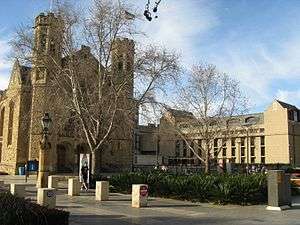 Bonython Hall & the Ligertwood Building (viewed from North Terrace).
Bonython Hall & the Ligertwood Building (viewed from North Terrace). Bust of Sir Douglas Mawson & the Elder Conservatorium of Music (viewed from North Terrace).
Bust of Sir Douglas Mawson & the Elder Conservatorium of Music (viewed from North Terrace).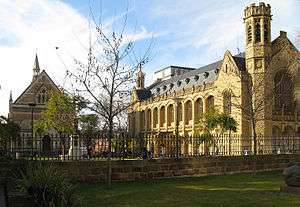 Bonython Hall & the Elder Conservatorium of Music (viewed from North Terrace).
Bonython Hall & the Elder Conservatorium of Music (viewed from North Terrace). Bonython Hall & the Elder Conservatorium of Music (viewed from the north).
Bonython Hall & the Elder Conservatorium of Music (viewed from the north).
 The Cloisters.
The Cloisters. The Cloisters and the Student Union Building.
The Cloisters and the Student Union Building. The Barr Smith Library with the Napier building visible in the background
The Barr Smith Library with the Napier building visible in the background Barr Smith Lawns.
Barr Smith Lawns. The old Adelaide Teachers College buildings, now part of the University.
The old Adelaide Teachers College buildings, now part of the University.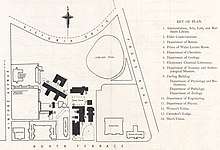 University of Adelaide site map 1926
University of Adelaide site map 1926
Organisation and governance
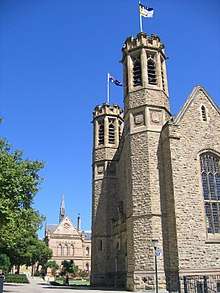
The university is divided into five faculties, with various constituent schools:
- Faculty of Engineering, Computer & Mathematical Sciences: Australian School of Petroleum; School of Chemical Engineering; School of Civil, Environmental & Mining Engineering; School of Computer Science; School of Electrical & Electronic Engineering; School of Mathematical Sciences; and, School of Mechanical Engineering.
- Faculty of Health and Medical Sciences: University of Adelaide School of Dentistry; School of Medicine, School of Nursing, School of Public Health, School of Psychology
- Faculty of Arts: Elder Conservatorium of Music; School of Humanities; School of Education; and, School of Social Sciences
- Faculty of the Professions: School of Architecture, and Built Environment; Adelaide Business School; School of Economics; and, Adelaide Law School.
- Faculty of Sciences: School of Agriculture, Food, and Wine; School of Physical Sciences; School of Biological Sciences; School of Animal and Veterinary Sciences.
The university has a long history of indigenous education, and established its first formal courses in the Centre for Aboriginal Studies in Music (CASM) in 1972. The recruitment, administration and support of indigenous students, as well as overseeing the Indigenous Employment Strategy and delivering Foundation Studies Programs, is conducted by Aboriginal and Torres Strait Islander Education: Wirltu Yarlu in the Division of the Deputy Vice-Chancellor and Vice-President (Academic).
The university currently enrolls in excess of 27,300 students, including over 7,400 international students (2015) from more than 100 countries. Adelaide University has approximately 130,000 Alumni worldwide, along with 400 student exchange agreements.
Residential colleges
The University of Adelaide, unlike most universities, did not set any land aside on its North Terrace campus for student accommodation, due mainly to an ideological opposition to the culture of live-in students, but also influenced by the small size of the original campus.[33] However, demand for residential college accommodation led to the establishment of private colleges affiliated to the university. St. Mark's College was founded by the Anglican Church (then called the Church of England) in 1925, Aquinas College in 1950 by the Catholic Church, Lincoln College in 1952 by the Methodist Church, and later St Ann's College, Kathleen Lumley College and Australian Lutheran College. All are located within close walking distance of the university, across the River Torrens in North Adelaide. In addition to providing accommodation and meals for local, interstate and international students, each college organises academic support, social activities and sporting opportunities for its members.
Governance
In 2018, Peter Rathjen commenced his tenure as 22nd Vice-Chancellor, taking over from Warren Bebbington (2012–17) and Interim VC Mike Brooks (2017–18). Rathjen is a Rhodes Scholar, a recipient of the R.A. Fisher Prize for genetics and the Morton Prize for biochemistry, and was the founding member of the Australian Centre of Excellence for Biotechnology. He is a world-renowned stem cell researcher, whose work in gene shearing formed the foundations for genetic engineering.[34]
In May 2020, Mike Brooks returned as Acting Vice-Chancellor. Rathjen formally resigned in July 2020; the 23rd VC is yet to be appointed.[35]
Academic profile
Commercialisation
The University of Adelaide has capitalised on opportunities to commercialise its research. The university has the highest volume of commercial research agreements of all Australian universities. It engages in extensive contract research and collaborative work in conjunction with local and international companies, as well as federal, state and local governments. This activity is managed by the university's commercial development company, Adelaide Research & Innovation Pty Ltd (ARI).[36]
Some examples of recent influences to the university's teaching and research priorities are the Defence Science and Technology Group (DSTG; previously the Defence Science and Technology Organisation, or DSTO) in Adelaide's northern suburbs to which the university provides many psychology, physics, engineering, and IT graduates; and the growth in South Australia's wine industry, which is supported by the Waite and National Wine Centre campuses producing oenology and agriculture/viticulture graduates.
In addition, the university participates in the Auto-ID Labs, a network of seven research universities in the field of networked radio-frequency identification (RFID) and emerging sensing technologies.
In August 2019, Primary Industries and Regions SA (PIRSA) and the South Australian Research and Development Institute (SARDI) entered a partnership with the university, in which scientists in diverse disciplines will be able to access PIRSA's research farms share their academic knowledge to the agricultural sector. The collaboration is anticipated to help develop SA's expertise in dryland agriculture, by encouraging multi-disciplinary research and help to bring about new export opportunities.[18]
Lectures
The university hosts a number of lecture series, including the Joseph Fisher Lecture in Commerce, established in 1903 following a donation by politician and newspaper proprietor Joseph Fisher of £1000 to the University "for the purpose of promoting the study of commerce". The Gavin David Young Lectures in Philosophy began in 1956, owing their existence to a bequest made by Jessie Frances Raven, in memory of her father, for "the promotion, advancement, teaching and diffusion of the study of philosophy…".[37] The university also presents the James Crawford Biennial Lecture Series on International Law, named for James Richard Crawford SC, a graduate of the university who went on to be Dean of Law at the University of Sydney and subsequently Whewell Professor of International Law at the University of Cambridge. Crawford delivered the first lecture in 2004. The university is one of a number of institutions to have established an Edward Said Memorial Lecture.[38] The first in this series was given in 2005.
Research
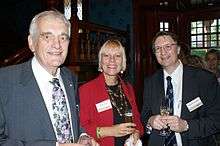
The University of Adelaide is one of the most research-intensive universities in Australia, securing over $180 million in research funding annually.[39] Its researchers are active in both basic and commercially oriented research across a broad range of fields including agriculture, psychology, health sciences, and engineering.[36]
Research strengths include engineering, mathematics, science, medical and health sciences, agricultural sciences, artificial intelligence, and the arts.[40]
The university is a member of Academic Consortium 21,[41] an association of 20 research intensive universities, mainly in Oceania, though with members from the US and Europe. The university held the Presidency of AC 21 for the period 2011–2013 as host the biennial AC21 International Forum in June 2012.
The Centre for Automotive Safety Research (CASR), based at the University of Adelaide, was founded in 1973 as the Road Accident Research Unit and focuses on road safety and injury control.[42]
Rankings
| University rankings | |
|---|---|
| Adelaide University | |
| QS World[43] | 106 |
| THE-WUR World[44] | 135 |
| ARWU World[45] | 101-150 |
| USNWR World[46] | 102 |
| CWTS Leiden World[47] | 143 |
| Australian rankings | |
| QS National[43] | 8 |
| THE-WUR National[48] | 8 |
| ARWU National[49] | 7-8 |
| USNWR National[50] | 8 |
| CWTS Leiden National[47] | 4 |
| ERA National[51] | 7[52] |
When averaging the world's major rankings, the University of Adelaide (106) appears to be ranked eighth in Australia, behind UWA (136), ANU (103), UNSW (64), Monash University (63), the University of Sydney (56), the University of Queensland (47), and the University of Melbourne (40).[53]
The University of Adelaide consistently features in the top 150 international universities as ranked by the Academic Ranking of World Universities, the QS World University Rankings, and the Times Higher Education World University Rankings,[54][55][56] situating it securely in the top 1% of ranked universities worldwide. The university's Faculty of Health and Medical Sciences, and Schools of Physical Sciences, Nursing, and Social Sciences and Humanities, in particular, are reliably ranked in the top 75 of their respective worldwide ranking.[57][58]
Student life
Associations
As of 1 July 2006, membership of the Adelaide University Union (AUU) has been voluntary for all students, following the passing of voluntary student unionism (VSU) legislation by the Federal Government. The AUU funds five affiliates which carry out their functions autonomously. They are the Adelaide Postgraduate Students’ Association (APGSA), the Clubs Association (CA), the Roseworthy Agricultural Campus Student Union Council (RACSUC), the Student Representative Council (preceded by the now defunct Students' Association of the University of Adelaide) and the Waite Institute Students' Association (WISA).
The Adelaide University Union was responsible for organising the annual Prosh (University of Adelaide) events.
Media
The University of Adelaide has three print news publications; these are:
- On Dit, the student magazine,[59]
- Adelaidean, the University's newspaper,[60]
- Lumen, the alumni magazine.[61]
The University of Adelaide Press publishes staff scholarship and works of interest about the history and activities of the University.[62] The Press is also responsible for publishing the Adelaide Law Review.
The University of Adelaide founded Australia's first community radio station, Radio Adelaide, in 1972.[63]
Opportunities to participate in theatre productions are available through the University of Adelaide Theatre Guild and the Law School Revue.
Sports
Most university sport is organised by the Adelaide University Sports Association (AUSA). The Sports Association was founded in 1896 by the Adelaide University Boat, Tennis and Lacrosse Clubs. The Association disaffiliated from the Adelaide University Union (AUU) on 1 January 2010 and is currently directly affiliated to the University of Adelaide. The AUSA supports 37 sporting clubs which provide a diverse range of sporting opportunities to students of the University of Adelaide (AU). The AUSA is a major stakeholder in the AU North Terrace Campus based Sports Hub fitness centre and the North Adelaide-based university playing fields.
Notable people
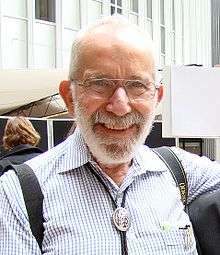
The history of the University of Adelaide includes a large number of distinguished alumni and staff, including domestic and international heads of state; Nobel laureates; business and political leaders; pioneers in science, mathematics, and medicine; media personalities; accomplished musical, visual, performance, and written artists; and sportspeople, including multiple Olympic medallists.
Distinguished alumni include 16 chancellors, 20 vice-chancellors, 110 Rhodes Scholars,[64] 5 Nobel laureates (one of whom was once the youngest laureate ever, Lawrence Bragg, co-recipient, with his father William Henry Bragg for physics in 1915, at 25 years of age[65]), and one Prime Minister (Julia Gillard, the first female Prime Minister of Australia) have all graduated or attended the University of Adelaide.[66][67][68][36]
Robin Warren, who alongside Barry Marshall, discovered that peptic ulcers were largely caused by the infection Helicobacter pylori, graduated from the university in the 1950s. Warren and Marshall won the Nobel Prize for their discovery in 2005.
Other notable graduates and professors include Leo Blair (the father of British Prime Minister Tony Blair; law lecturer at the University of Adelaide while Tony was a child); Edward Charles Stirling (physiologist, politician and advocate for women's suffrage), Tim Flannery (Australian of the Year), Brendon Coventry (who helped discover the immune cycle),[69] Maciej Henneberg (physical anthropologist, Howard Florey (pharmacologist and pathologist who shared the Nobel Prize in Physiology or Medicine in 1945 with Sir Ernst Chain and Sir Alexander Fleming for his role in the development of penicillin), J.M. Coetzee (novelist and linguist, recipient of the 2003 Nobel Prize in Literature), Ghil'ad Zuckermann (linguist and revivalist), Margaret Reid (first female president of the Australian Senate), Janine Haines (first female federal parliamentary leader of an Australian political party), Margaret White (first female judge of the Supreme Court of Queensland), Roma Mitchell (first female Queen's Counsel in Australia (1962), Justice of the Supreme Court of South Australia and the first female superior court judge in the British Commonwealth (1965) and first female state Governor), and Joni Madraiwiwi, Vice-President of the Republic of Fiji and Chief Justice of the Republic of Nauru.[70][71]
Partnerships
- Royal Adelaide Hospital
- Hanson Institute
See also
- List of universities in Australia
- The Environment Institute
- University of Adelaide College, a pre-University pathways College for international students
References
- "2016 Endowment Fund Investment Report" (PDF). adelaide.edu.au. Retrieved 3 March 2018.
- "2017 University of Adelaide Annual Report" (PDF). adelaide.edu.au. Retrieved 30 July 2019.
- "University of Adelaide appoints its 17th Chancellor". Newsroom. University of Adelaide. Retrieved 15 July 2020.
- "2018 Pocket Statistics" (PDF). Retrieved 18 October 2018.
- "University of Adelaide - World University Rankings - 2013-14". TES Global Ltd.
- Walker, R. B. "Davidson, John (1834–1881)". Australian Dictionary of Biography. Melbourne University Press. ISSN 1833-7538. Retrieved 8 December 2013 – via National Centre of Biography, Australian National University.
- Ruby Davy, Australian Dictionary of Biography, adb.anu.edu.au
- Neville Hicks and Elisabeth Leopold, 'Mayo, Helen Mary (1878–1967)', Australian Dictionary of Biography, National Centre of Biography, Australian National University, 1986. Retrieved 18 April 2018.
- W. B. Pitcher, 'Bonython, Sir John Langdon (1848–1939)', Australian Dictionary of Biography, National Centre of Biography, Australian National University, 1979. Retrieved 18 April 2018.
- "The University of Adelaide | A Smoke-Free University". Adelaide.edu.au. 1 July 2010. Archived from the original on 1 December 2010. Retrieved 26 September 2010.
- "Award recognises 30 years of anti-smoking work". Adelaide.edu.au. 9 October 2009. Retrieved 26 September 2010.
- Griffiths, Luke. "South Australian universities in merger talks". The Australian. Retrieved 19 June 2018.
- University of Adelaide and UniSA to explore potential merger to create new institution ABC News, 19 June 2018. Retrieved 19 June 2018.
- University of Adelaide and UniSA decide against merger ABC News, 23 October 2018. Retrieved 24 October 2018.
- "A Pioneer for Women in Health and Academia: Dr Helen Mayo" (PDF). University of Adelaide. Retrieved 3 December 2019. Cite journal requires
|journal=(help) - "University of Adelaide masterplan to overhaul North Tce campus". Adelaide Now. Retrieved 2 January 2017.
- "Uni of Adelaide 20-year masterplan to revitalise North Terrace". University of Adelaide. Retrieved 2 January 2017.
- Spence, Andrew; Anderson, Elizabeth (16 August 2019). "PIRSA, SARDI partnership with University of Adelaide helps dryland innovation". Stock Journal. Retrieved 26 March 2020.
- "Before the Public". The News. Adelaide. 10 November 1924. p. 9 Edition: Home. Retrieved 17 November 2015 – via National Library of Australia.
- "GIFT OF £10,000 TO THE UNIVERSITY". The Advertiser. Adelaide. 5 June 1929. p. 8. Retrieved 30 November 2011 – via National Library of Australia.
- "Rural, farming and agricultural industry news". stockjournal.com.au. Retrieved 1 November 2015.
- Clare Peddie,"Green light on plant growth", Adelaide Advertiser 29 Jan 2010
- Lynette D. Zeitz, The Waite. A Social and Scientific History of the Waite Agricultural Research Institute, University of Adelaide Press, 2014, pp.82-85.
- "Australian Winemaking, The Roseworthy Influence", Geoffrey Bishop 1980, Investigator Press Pty Ltd
- "The University of Adelaide". www.adelaide.edu.au.
- "National Wine Centre of Australia". State Library of South Australia. Government of South Australia. 16 May 2006. Retrieved 15 November 2013.
- "National Wine Centre". Australian Institute of Architects. Retrieved 15 November 2013.
- TEC group – now referred to as the Centre for Energy Technology (CET).
- NAAEC, Ngee Ann – Adelaide Education Centre, http://www.adelaide.edu.au/sg/
- Ngee Ann Kongsi Archived 14 September 2008 at the Wayback Machine foundation, www.ngeeann.com.sg
- "Singapore growth strategy for University". Adelaide.edu.au. 21 April 2008. Retrieved 19 October 2010.
- "About". Ngee Ann Academy. Retrieved 3 December 2019.
- Gavin Walkley, St Mark's College: The Buildings and Grounds
- Clark, Nick (30 May 2017). "University of Tasmania vice-chancellor Peter Rathjen takes post at University of Adelaide". The Mercury. Retrieved 30 May 2017.
- https://www.theaustralian.com.au/higher-education/university-of-adelaide-in-global-hunt-for-new-vicechancellor-as-talk-of-merger-rekindled/news-story/35a22ef0825ed265b6f7a481c552f630
- "2017 Pocket Statistics" (PDF). University of Adelaide. Retrieved 17 July 2017.
- "Gavin David Young Lectures". University of Adelaide. Archived from the original on 21 September 2013. Retrieved 20 September 2013.
- "About the Edward Said Memorial Lecture". University of Adelaide. Retrieved 17 October 2009.
- "2014 Pocket Statistics" (PDF). University of Adelaide. Retrieved 1 November 2015.
- https://www.adelaide.edu.au/research/about-us/era/
- "HOME – Academic Consortium 21". ac21.org. Retrieved 1 November 2015.
- https://ecms.adelaide.edu.au/centre-for-automotive-safety-research/home
- "QS World University Rankings 2021". Quacquarelli Symonds Limited.
- "World University Rankings 2020". TSL Education Limited.
- "Academic Ranking of World Universities 2019". Shanghai Ranking Consultancy.
- "U.S. News and World Report Best Global Universities Rankings". U.S. News and World Report.
- "CWTS Leiden Ranking 2017". Centre for Science and Technology Studies, Leiden University.
- "THE 2020 - Australia". Times Higher Education.
- "Academic Ranking of World Universities 2019 - Australia". Shanghai Ranking Consultancy.
- "U.S. News and World Report Best Global Universities in Australia/New Zealand". U.S. News and World Report.
- "Australian University Rankings". Australian Education Network.
- "All unis winners in research audit". The Australian. 4 December 2015. Retrieved 21 February 2017.
- "Group of Eight (Australian universities)", Wikipedia, 5 March 2020, retrieved 5 March 2020
- "Academic Ranking of World Universities 2016". Shanghai Ranking Consultancy. Retrieved 17 December 2016.
- "QS World University Rankings". QS Quacquarelli Symonds Limited. Retrieved 17 December 2016.
- "Top Universities in Australia 2017". Times Higher Education. Retrieved 17 December 2016.
- "University of Adelaide World Rankings by Faculty". QS World Rankings. Retrieved 17 December 2016.
- "University of Adelaide World Rankings". Times Higher Education. Retrieved 17 December 2016.
- "On Dit". Auu.org.au. Archived from the original on 24 January 2011. Retrieved 26 September 2010.
- "Adelaidean – September 2010 contents". Adelaide.edu.au. Retrieved 26 September 2010.
- "lumen – Lumen Winter 2010 contents". Adelaide.edu.au. Retrieved 26 September 2010.
- University's e-press recasts publishing model, 11 November 2009, The Australian
- "Radio Adelaide". Radio Adelaide. Archived from the original on 28 June 2010. Retrieved 26 September 2010.
- INDIGENOUS DOCTOR IS RHODES SCHOLAR FOR SOUTH AUSTRALIA, Thursday, 26 October 2017.
- "Lawrence Bragg – Biographical". Nobel Foundation. Retrieved 26 October 2014.
- Curtis, L.; Hall, E. (24 June 2010). "Gillard becomes first female PM". ABC News. Australian Broadcasting Corporation. Retrieved 13 October 2010.
- "Australia's new PM pays tribute to her 'great education'". The University of Adelaide. 24 June 2010.
- "Officers & Honorary Degree Holders of the University". adelaide.edu.au. Retrieved 26 October 2015.
- Brendon J Coventry et al. CRP identifies homeostatic immune oscillations in cancer patients: a potential treatment targeting tool? Journal of Translational Medicine 7 (2009)
- http://www.naurugov.nr/government-information-office/media-release/nauru-mourns-passing-of-chief-justice.aspx
- https://www.smh.com.au/world/former-judge-is-fiji-vp-nominee-report-20041214-gdkb3g.html